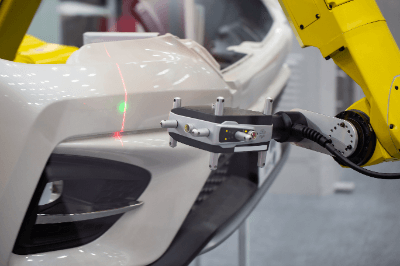What Is a Coordinate Measuring Machine (CMM)?
 A coordinate measuring machine (CMM) is an instrument capable of measuring surface features at the submicron level(smaller than 1/1,000 of a millimeter). 3D coordinate measuring machines can capture the shape of a part in three dimensions and perform a variety of measurements.
A coordinate measuring machine (CMM) is an instrument capable of measuring surface features at the submicron level(smaller than 1/1,000 of a millimeter). 3D coordinate measuring machines can capture the shape of a part in three dimensions and perform a variety of measurements.
They are also used to measure the surface roughness, height, and thickness of electronic component substrates and semiconductors. They are characterized by high speed, high resolution, and high accuracy.
There are also various types of coordinate measuring machinery depending on the installation and measurement methods. There are stationary and portable types in terms of installation method, contact-and non-contact types, laser tracker, layout machine, etc. in terms of measurement method.
Uses of Coordinate Measuring Machinery (CMM)
Applications of coordinate measuring machinery are as follows:
1. Line Roughness Measurement
Coordinate measuring machinery can measure typical surface roughness parameters such as Ra, Rz, etc., as well as a stylus-type surface roughness.
2. Surface Roughness Measurement
Coordinate measuring machines can measure waviness and steps between surfaces with high accuracy by measuring the entire surface. Examples include washer waviness evaluation and block gauge step measurement.
3. Plane Measurement
Coordinate measuring machines are used to measure the distance between two points: straight lines, circular centers, and various other flat surfaces. They are used in all industries, including the medical device, archaeology, molding, and watch industries.
Principle of Coordinate Measuring Machinery
Most coordinate measuring machinery (CMM) uses white light interferometry, a measurement method that uses a white light interferometer. Light interference is a phenomenon that occurs when there is a difference in the phase of light from two sources. Optical interferometers use this phenomenon to measure the state of surface irregularities, for example.
The interference of light causes a stripe pattern to appear due to the optical path difference generated by the unevenness of the sample surface. The number of stripes indicates the height of the unevenness of the sample surface. In actual use, an objective lens with a built-in reference mirror, called an interference lens, is used. White light is irradiated onto the reference mirror and objective lens, and the interference signal is observed by a camera while the objective lens is moved up and down.
Some models are also equipped with a high-sensitivity CMOS, a semiconductor that converts light entering through the lens into electrical signals. A solid-state imaging device using CMOS can capture an external image at the same time as the shape, allowing surface observation and measurement at the same time. The analysis contents are converted into data, such as a 3D model, which can be viewed on a CAD system.
More Information on the Coordinate Measuring Machinery
1. 3D Coordinate Measuring Machinery (CMM) Functions
Coordinate measuring machines (CMM) available on the market today use the latest technology and can easily perform measurements that were impossible in the past. The 3D coordinates of a specific point from a virtual origin are considered difficult to measure with common measuring instruments, such as calipers and micrometers.
Also, measurements using virtual points and lines and geometric tolerances are also extremely difficult to conduct with other measuring instruments, but coordinate measuring machinery (CMM) can perform them. Recently, it has become possible to read the shape of a prototype in 3D and create a 3D object using a 3D printer to check the shape in the same way as the actual product.
2. Issues and Solutions for Coordinate Measuring Machinery (CMM)
The efficiency of measurement work has been dramatically improved by the highly accurate measurement technology of coordinate measuring machinery (CMM) and the increased processing speed of measurement data, but there are also the following issues:
- High cost of installation
- Large installation space and high maintenance requirements
- The size of the CMM itself is limited, which in turn limits the size of the objects that can be measured.
CMM with an articulated arm have emerged as a solution to these problems. Originally developed for manufacturers of prosthetic arms and legs, the technology is now used in transportable CMM.
The ability to move the arm at the will of the operator has further expanded the range of measurements that can be taken. The introduction of non-contact measurement using lasers has also made it possible to measure large objects.